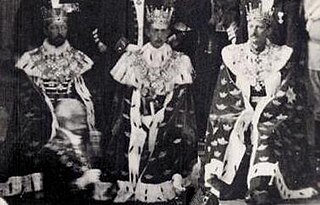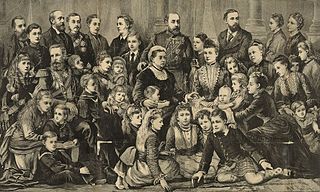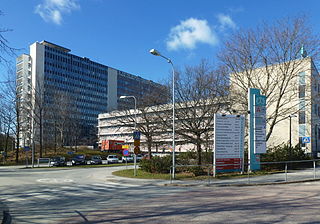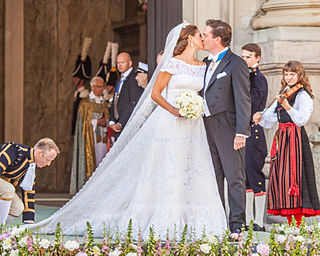
Victoria, Crown Princess of Sweden, Duchess of Västergötland is the heir apparent to the Swedish throne, as the eldest child of King Carl XVI Gustaf. If she ascends to the throne as expected, she would be Sweden's fourth queen regnant and the first since 1720. Her inheritance is secured by Sweden's 1979 Act of Succession, the first law in Western Europe to adopt royal absolute primogeniture.

Carl XVI Gustaf is King of Sweden.

The House of Bernadotte is the royal family of Sweden, founded there in 1818 by King Charles XIV John of Sweden. It was also the royal family of Norway between 1818 and 1905. Its founder was born in Pau in southern France as Jean Bernadotte. Bernadotte, who had been made a General of Division and Minister of War for his service in the French Army during the French Revolution, and Marshal of the French Empire and Prince of Ponte Corvo under Napoleon, was adopted by the elderly King Charles XIII of Sweden, who had no other heir and whose Holstein-Gottorp branch of the House of Oldenburg thus was soon to be extinct on the Swedish throne. The current king of Sweden, Carl XVI Gustaf, is a direct descendant of Charles XIV John.

Princess Ingeborg of Denmark, was a Princess of Sweden by marriage to Prince Carl, Duke of Västergötland.

Count of Wisborg is a title granted by the monarchs of Luxembourg to some men formerly titled as princes of Sweden and their descendants.

Prince Carl of Sweden and Norway, Duke of Västergötland was a Swedish prince. Through his daughters Märtha and Astrid, for whom he arranged excellent dynastic marriages, he is an ancestor of current members of the Grand Ducal Family of Luxembourg, Belgian royal family and Norwegian royal family.

Princess Margaretha of Sweden was a member of the Swedish Royal Family by birth and the Danish Royal Family by marriage. She was the elder sister of Crown Princess Märtha of Norway and Queen Astrid of the Belgians.

Duchies in Sweden have been allotted since the 13th century to powerful Swedes, almost always to princes of Sweden and wives of the latter. From the beginning these duchies were often centers of regional power, where their dukes and duchesses had considerable executive authority of their own, under the central power of their kings or queens regnant. Since the reign of King Gustav III the titles have practically been nominal, with which their bearers only rarely have enjoyed any ducal authority, though often maintaining specially selected leisure residences in their provinces and some limited measure of cultural attachment to them.

The line of succession to the Swedish throne is determined by the Act of Succession, originally approved jointly by the Riksdag of the Estates assembled in Örebro and King Charles XIII in 1810.
Royal Highness is a style used to address or refer to some members of royal families, usually princes or princesses. Kings and their female consorts, as well as queens regnant, are usually styled Majesty.

Princess Sibylla of Saxe-Coburg and Gotha was a member of the Swedish royal family and the mother of the current king of Sweden, Carl XVI Gustaf.

Kungliga begravningsplatsen, known in English as the Royal Cemetery, was first used in 1922 and has been the only official burial place of the Swedish royal family since 1950, succeeding Riddarholmen Church as such. It takes up all of the small island of Karlsborg in the bay of Brunnsviken. The cemetery is part of the popular Haga Park in Solna, Sweden.

Queen Victoria, the British monarch from 1837 to 1901, and Prince Albert had 9 children, 42 grandchildren, and 87 great-grandchildren. Victoria was called the "grandmother of Europe".

Danderyd Hospital is a teaching hospital in Danderyd Municipality in northern Greater Stockholm opened in 1922. Until 1964 it was called Centrallasarettet i Stocksund.

The wedding of Princess Madeleine, Duchess of Hälsingland and Gästrikland, and the British-born American financier Christopher O'Neill took place in Stockholm on 8 June 2013.

The wedding of Prince Carl Philip, Duke of Värmland, and Sofia Hellqvist took place on 13 June 2015 at Slottskyrkan, Stockholm.

A royal christening gown is an item of baptismal clothing used by a royal family at family christenings. Among those presently using such a gown are the royal families of the United Kingdom, Denmark, the Netherlands, Norway, Spain, and Sweden. In most of these families, the tradition goes back over a century: as of 2019, the Swedish gown has been in service for 113 years, the Dutch gown for 139 years, and the Danish gown for 149 years; the current British gown has been in use since 2008. The Spanish gown has been in use for 81 years.

The wedding of Carl XVI Gustaf, King of Sweden, and Silvia Sommerlath took place on Friday, 19 June 1976 at Storkyrkan. Carl XVI Gustaf had been king of Sweden since 1973 and Sommerlath was a German-born translator. The couple had met at the 1972 Summer Olympic Games in Munich and became engaged in 1976.

The Golden Jubilee of Carl XVI Gustaf was celebrated in 2023 in the Kingdom of Sweden, to mark the 50th anniversary of the accession of King Carl XVI Gustaf on 15 September 1973. He is the first Swedish monarch to celebrate a Golden Jubilee. The 500th anniversary of Sweden's regained independence, through the election of King Gustav I, was also marked during the Jubilee year.





















